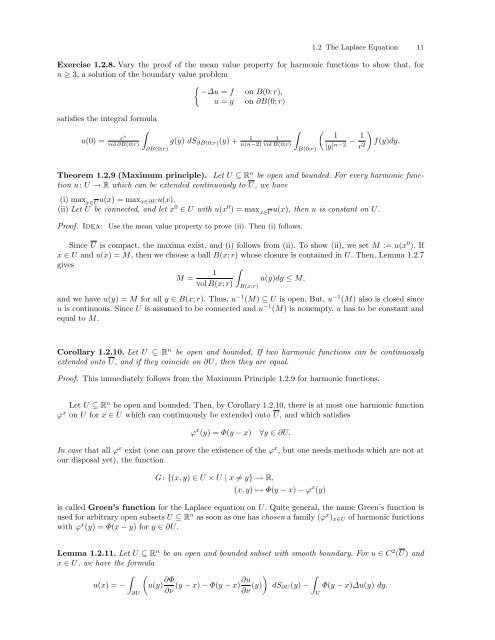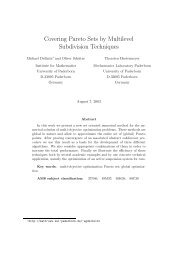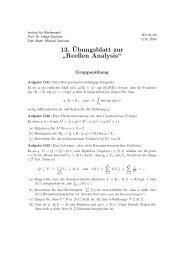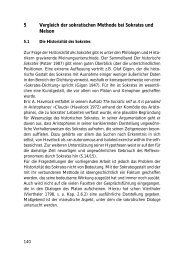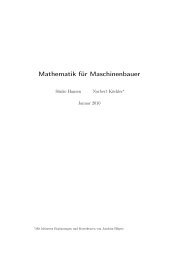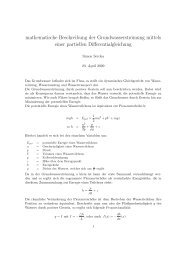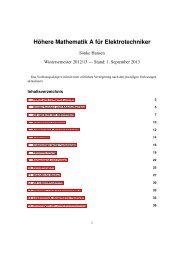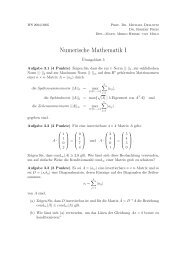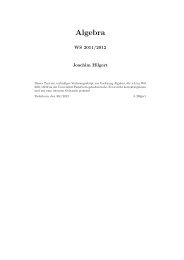Partial Differential Equations
Partial Differential Equations
Partial Differential Equations
Create successful ePaper yourself
Turn your PDF publications into a flip-book with our unique Google optimized e-Paper software.
1.2 The Laplace Equation 11<br />
Exercise 1.2.8. Vary the proof of the mean value property for harmonic functions to show that, for<br />
n ≥ 3, a solution of the boundary value problem<br />
{ −∆u = f on B(0; r),<br />
satisfies the integral formula<br />
∫<br />
u(0) =<br />
r n<br />
vol ∂B(0;r)<br />
∂B(0;r)<br />
u = g on ∂B(0; r)<br />
g(y) dS ∂B(0;r) (y) + 1<br />
1<br />
n(n−2) vol B(0;r)<br />
∫<br />
B(0;r)<br />
( 1<br />
|y| n−2 − 1 r 2 )<br />
f(y)dy.<br />
Theorem 1.2.9 (Maximum principle). Let U ⊆ R n be open and bounded. For every harmonic function<br />
u: U → R which can be extended continuously to U, we have<br />
(i) max x∈U<br />
u(x) = max x∈∂U u(x).<br />
(ii) Let U be connected, and let x 0 ∈ U with u(x 0 ) = max x∈U<br />
u(x), then u is constant on U.<br />
Proof. Idea: Use the mean value property to prove (ii). Then (i) follows.<br />
Since U is compact, the maxima exist, and (i) follows from (ii). To show (ii), we set M := u(x 0 ). If<br />
x ∈ U and u(x) = M, then we choose a ball B(x; r) whose closure is contained in U. Then, Lemma 1.2.7<br />
gives<br />
∫<br />
1<br />
M =<br />
u(y)dy ≤ M,<br />
vol B(x; r) B(x;r)<br />
and we have u(y) = M for all y ∈ B(x; r). Thus, u −1 (M) ⊆ U is open. But, u −1 (M) also is closed since<br />
u is continuous. Since U is assumed to be connected and u −1 (M) is nonempty, u has to be constant and<br />
equal to M.<br />
Corollary 1.2.10. Let U ⊆ R n be open and bounded. If two harmonic functions can be continuously<br />
extended onto U, and if they coincide on ∂U, then they are equal.<br />
Proof. This immediately follows from the Maximum Principle 1.2.9 for harmonic functions.<br />
Let U ⊆ R n be open and bounded. Then, by Corollary 1.2.10, there is at most one harmonic function<br />
ϕ x on U for x ∈ U which can continuously be extended onto U, and which satisfies<br />
ϕ x (y) = Φ(y − x)<br />
∀y ∈ ∂U.<br />
In case that all ϕ x exist (one can prove the existence of the ϕ x , but one needs methods which are not at<br />
our disposal yet), the function<br />
G: {(x, y) ∈ U × U | x ≠ y} → R,<br />
(x, y) ↦→ Φ(y − x) − ϕ x (y)<br />
is called Green’s function for the Laplace equation on U. Quite general, the name Green’s function is<br />
used for arbitrary open subsets U ⊆ R n as soon as one has chosen a family (ϕ x ) x∈U of harmonic functions<br />
with ϕ x (y) = Φ(x − y) for y ∈ ∂U.<br />
Lemma 1.2.11. Let U ⊆ R n be an open and bounded subset with smooth boundary. For u ∈ C 2 (U) and<br />
x ∈ U, we have the formula<br />
∫ (<br />
u(x) = − u(y) ∂Φ<br />
)<br />
∫<br />
(y − x) − Φ(y − x)∂u<br />
∂U ∂ν ∂ν (y) dS ∂U (y) − Φ(y − x)∆u(y) dy.<br />
U


